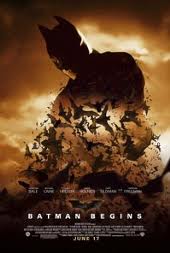
In my last post, I discussed the variations on the most prominent theme in Batman Begins: a two-note motive of D-F for Batman. But there are three other themes that appear in the film at prominent moments. These are described below in a film music analysis.
The “Thoughts of Death” Theme
This theme appears twice in the film, the first time after the young Bruce Wayne’s parents are shot dead and there is a cut from the crime scene to the police station where Bruce is being cared for. The music features a wordless boy soprano singing three phrases:

Because this theme isn’t heard until after Bruce’s parents have been killed, it does not represent the sorrow of the scene in general, as is typically done, but rather Bruce’s sorrow in having witnessed the death of his parents. Hear it in this clip:
This theme also appears when Bruce returns to Gotham as a young adult for the court hearing for the early release of Chill, the man who killed his parents. As Bruce unpacks in his room at Wayne Manor, he reveals a handgun he had packed in his suitcase. At this moment the theme returns, indicating that Bruce is not only contemplating the death of his parents but, as the handgun implies, killing Chill as well. For this reason, I call it the “Thoughts of Death” theme.
The “Succeeding” Themes
These themes appear in a few key scenes:
- When the adult Bruce lowers himself into the well and starts to create the Batcave
- When Batman brings in his “backup”—a flurry of bats—to distract police while he saves Rachel
Succeeding Theme 1

Succeeding Theme 2

Succeeding Theme 3

These themes are used interchangeably and are heard when Bruce or Batman is in the process of overcoming some obstacle. This process is why I say it is a “succeeding” theme and not simply a “success” theme. Notice that they are all in the same D minor key as the main Batman motives, further associating the themes with Bruce/Batman. Hear the clip below from 0:38 for Theme 1, which then leads into Theme 3 at 0:55 (beginning in slightly varied form).
And Theme 2 can be heard below from 0:39:
The Love Theme
This theme is quite long but this is its most prominent portion:

This portion of the theme occurs at two important spots:
- When young Bruce is on the elevated train listening to his father talk about how he helps the city
- When Bruce and Rachel kiss in the burnt out rubble of Wayne Manor
Here’s an audio clip of theme starting from 1:57:
Interestingly, this theme is not limited just to romantic love, as these themes typically are, but it also expresses the familial love Bruce feels for his parents.
Coming soon—Musical Themes, Part 3: The Dark Knight.
Good evening. I am a graduate student working on a Master’s in Music Theory. This website is a great resource, and I have thoroughly enjoyed browsing through. Are there any augmented sixth chords in any of the film scores you’ve analyzed? I know there MUST be one, somewhere, anywhere. But I am about to pull my hair out searching. Please, if you can, provide some relief and tell me where I can find some augmented sixths.
Dear Claire,
You ask a great question about augmented sixths in film music. The truth is, as you seem to have discovered, that they are scarce in the repertoire, especially if you’re looking in main themes. One notable exception is Hedwig’s Theme (the Harry Potter main theme), in the fourth bar of the B section (the 1st time around), we get E-C-A#, but even here it’s resolution, although to V, is unconventional in that the ^#4 doesn’t to go ^5, and the chord does not have the usual ^b6 in the bass but rather in an upper voice. Also, this chord is changed to V4/2 of V when the B section repeats.
But augmented sixths that behave the same way as in common-practice music are indeed difficult to find. Going back to silent films, there was the so-called “Mysterioso Pizzicato” theme that was used as villain’s music and became a cliche (hear it on YouTube).
I’m fairly certain there are a good number of augmented sixths In the Classical Hollywood era, I just haven’t made a formal list. But I know of a few to get you started. The main title of Steiner’s King Kong (1933) has an inverted augmented sixth (diminished third chord) after the initial “Kong” motif, and there’s a French sixth after the natives’ theme that leads into the lyrical setting of the “Kong” motif.
Also have a listen to Waxman’s score for The Bride of Frankenstein. In the main title, there is a common-tone augmented sixth (same chord that goes to V, but instead it goes to I) in the romantic-style music that follows the dissonant introductory theme. Waxman actually repeats this trick in his lush main theme for Hitchcock’s Rebecca (1940).
You could probably also find a number of these chords in Broadway-style songs of the era, one example being the “Washing Song” from Snow White and the Seven Dwarfs which, just before the cadence to the first phrase, has a clear, traditional German sixth.
It gets harder to think of examples after the 40s because many more musical styles entered the Hollywood vocabulary. But since Classical Hollywood was closely tied to late Romanticism and the early 20th century, your best bet for locating more augmented sixth chords is probably with that repertoire. I hope this helps.
This website is very very useful and informative.Thank you for everything